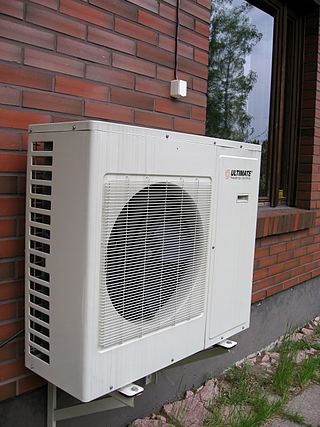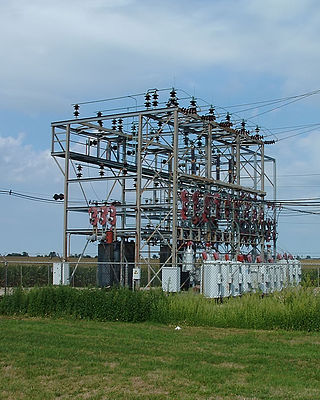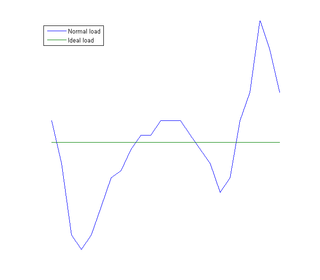Energy demand management, also known as demand-side management (DSM) or demand-side response (DSR), [1] is the modification of consumer demand for energy through various methods such as financial incentives [2] and behavioral change through education.
Usually, the goal of demand-side management is to encourage the consumer to use less energy during peak hours, or to move the time of energy use to off-peak times such as nighttime and weekends. [3] Peak demand management does not necessarily decrease total energy consumption, but could be expected to reduce the need for investments in networks and/or power plants for meeting peak demands. An example is the use of energy storage units to store energy during off-peak hours and discharge them during peak hours. [4]
A newer application for DSM is to aid grid operators in balancing variable generation from wind and solar units, particularly when the timing and magnitude of energy demand does not coincide with the renewable generation. Generators brought on line during peak demand periods are often fossil fuel units. Minimizing their use reduces emissions of carbon dioxide and other pollutants. [5] [6]
The term DSM was coined following the time of the 1973 energy crisis and 1979 energy crisis. [7] Governments of many countries mandated performance of various programs for demand management. An early example is the National Energy Conservation Policy Act of 1978 in the U.S., preceded by similar actions in California and Wisconsin. Demand-side management was introduced publicly by Electric Power Research Institute (EPRI) in the 1980s. [8] Nowadays, DSM technologies become increasingly feasible due to the integration of information and communications technology and the power system, new terms such as integrated demand-side management (IDSM), or smart grid. [9] [10]
The American electric power industry originally relied heavily on foreign energy imports, whether in the form of consumable electricity or fossil fuels that were then used to produce electricity. During the time of the energy crises in the 1970s, the federal government passed the Public Utility Regulatory Policies Act (PURPA), hoping to reduce dependence on foreign oil and to promote energy efficiency and alternative energy sources. This act forced utilities to obtain the cheapest possible power from independent power producers, which in turn promoted renewables and encouraged the utility to reduce the amount of power they need, hence pushing forward agendas for energy efficiency and demand management. [11]
Electricity use can vary dramatically on short and medium time frames, depending on current weather patterns. Generally the wholesale electricity system adjusts to changing demand by dispatching additional or less generation. However, during peak periods, the additional generation is usually supplied by less efficient ("peaking") sources. Unfortunately, the instantaneous financial and environmental cost of using these "peaking" sources is not necessarily reflected in the retail pricing system. In addition, the ability or willingness of electricity consumers to adjust to price signals by altering demand (elasticity of demand) may be low, particularly over short time frames. In many markets, consumers (particularly retail customers) do not face real-time pricing at all, but pay rates based on average annual costs or other constructed prices.[ citation needed ]
Energy demand management activities attempt to bring the electricity demand and supply closer to a perceived optimum, and help give electricity end users benefits for reducing their demand. In the modern system, the integrated approach to demand-side management is becoming increasingly common. IDSM automatically sends signals to end-use systems to shed load depending on system conditions. This allows for very precise tuning of demand to ensure that it matches supply at all times, reduces capital expenditures for the utility. Critical system conditions could be peak times, or in areas with levels of variable renewable energy, during times when demand must be adjusted upward to avoid over-generation or downward to help with ramping needs.[ citation needed ]
In general, adjustments to demand can occur in various ways: through responses to price signals, such as permanent differential rates for evening and day times or occasional highly priced usage days, behavioral changes achieved through home area networks, automated controls such as with remotely controlled air-conditioners, or with permanent load adjustments with energy efficient appliances.[ citation needed ]
Demand for any commodity can be modified by actions of market players and government (regulation and taxation). Energy demand management implies actions that influence demand for energy. DSM was originally adopted in electricity, but today it is applied widely to utilities including water and gas as well.[ citation needed ]
Vitality request shifts broadly among locales with diverse populace conveyances, family sizes, engineering highlights, capacities and social frameworks. Altering territorial control supply levels concurring to territorial request are broadly embraced. [12] Reducing energy demand is contrary to what both energy suppliers and governments have been doing during most of the modern industrial history. Whereas real prices of various energy forms have been decreasing during most of the industrial era, due to economies of scale and technology, the expectation for the future is the opposite. Previously, it was not unreasonable to promote energy use as more copious and cheaper energy sources could be anticipated in the future or the supplier had installed excess capacity that would be made more profitable by increased consumption.[ citation needed ]
In centrally planned economies subsidizing energy was one of the main economic development tools. Subsidies to the energy supply industry are still common in some countries.[ citation needed ]
Contrary to the historical situation, energy prices and availability are expected to deteriorate. Governments and other public actors, if not the energy suppliers themselves, are tending to employ energy demand measures that will increase the efficiency of energy consumption.[ citation needed ]
Broadly, demand side management can be classified into four categories: national scale, utility scale, community scale, and individual household scale.
Energy efficiency improvement is one of the most important demand side management strategies. [19] Efficiency improvements can be implemented nationally through legislation and standards in housing, building, appliances, transport, machines, etc.
During peak demand time, utilities are able to control storage water heaters, pool pumps and air conditioners in large areas to reduce peak demand, e.g. Australia and Switzerland. One of the common technologies is ripple control: high frequency signal (e.g. 1000 Hz) is superimposed to normal electricity (50 or 60 Hz) to switch on or off devices. [20] In more service-based economies, such as Australia, electricity network peak demand often occurs in the late afternoon to early evening (4pm to 8pm). Residential and commercial demand is the most significant part of these types of peak demand. [21] Therefore, it makes great sense for utilities (electricity network distributors) to manage residential storage water heaters, pool pumps, and air conditioners.
Other names can be neighborhood, precinct, or district. Community central heating systems have been existing for many decades in regions of cold winters. Similarly, peak demand in summer peak regions need to be managed, e.g. Texas & Florida in the U.S., Queensland and New South Wales in Australia. Demand side management can be implemented in community scale to reduce peak demand for heating or cooling. [22] [23] Another aspect is to achieve Net zero-energy building or community. [24]
Managing energy, peak demand and bills in community level may be more feasible and viable, because of the collective purchasing power, the bargaining power, more options in energy efficiency or storage, [25] more flexibility and diversity in generating and consuming energy at different times, e.g. using PV to compensate day time consumption or for energy storage.
In areas of Australia, more than 30% (2016) of households have rooftop photo-voltaic systems. It is useful for them to use free energy from the sun to reduce energy import from the grid. Further, demand side management can be helpful when a systematic approach is considered: the operation of photovoltaic, air conditioner, battery energy storage systems, storage water heaters, building performance and energy efficiency measures. [26]
The utility companies in the state of Queensland, Australia have devices fitted onto certain household appliances such as air conditioners or into household meters to control water heater, pool pumps etc. These devices would allow energy companies to remotely cycle the use of these items during peak hours. Their plan also includes improving the efficiency of energy-using items and giving financial incentives to consumers who use electricity during off-peak hours, when it is less expensive for energy companies to produce. [27]
Another example is that with demand side management, Southeast Queensland households can use electricity from rooftop photo-voltaic system to heat up water. [28]
In 2008, Toronto Hydro, the monopoly energy distributor of Ontario, had over 40,000 people signed up to have remote devices attached to air conditioners which energy companies use to offset spikes in demand. Spokeswoman Tanya Bruckmueller says that this program can reduce demand by 40 megawatts during emergency situations. [29]
The Alcoa Warrick Operation is participating in MISO as a qualified demand response resource, which means it is providing demand response in terms of energy, spinning reserve, and regulation service. [30] [31]
Demand-side management can apply to electricity system based on thermal power plants or to systems where renewable energy, as hydroelectricity, is predominant but with a complementary thermal generation, for instance, in Brazil.
In Brazil's case, despite the generation of hydroelectric power corresponds to more than 80% of the total, to achieve a practical balance in the generation system, the energy generated by hydroelectric plants supplies the consumption below the peak demand. Peak generation is supplied by the use of fossil-fuel power plants. In 2008, Brazilian consumers paid more than U$1 billion [32] for complementary thermoelectric generation not previously programmed.
In Brazil, the consumer pays for all the investment to provide energy, even if a plant sits idle. For most fossil-fuel thermal plants, the consumers pay for the "fuels" and other operation costs only when these plants generate energy. The energy, per unit generated, is more expensive from thermal plants than from hydroelectric. Only a few of the Brazilian's thermoelectric plants use natural gas, so they pollute significantly more than hydroelectric plants. The power generated to meet the peak demand has higher costs—both investment and operating costs—and the pollution has a significant environmental cost and potentially, financial and social liability for its use. Thus, the expansion and the operation of the current system is not as efficient as it could be using demand side management. The consequence of this inefficiency is an increase in energy tariffs that is passed on to the consumers.[ citation needed ]
Moreover, because electric energy is generated and consumed almost instantaneously, all the facilities, as transmission lines and distribution nets, are built for peak consumption. During the non-peak periods their full capacity is not utilized.[ citation needed ]
The reduction of peak consumption can benefit the efficiency of the electric systems, like the Brazilian system, in various ways: as deferring new investments in distribution and transmission networks, and reducing the necessity of complementary thermal power operation during peak periods, which can diminish both the payment for investment in new power plants to supply only during the peak period and the environmental impact associated with greenhouse gas emission.[ citation needed ]
Some people argue that demand-side management has been ineffective because it has often resulted in higher utility costs for consumers and less profit for utilities. [33]
One of the main goals of demand side management is to be able to charge the consumer based on the true price of the utilities at that time. If consumers could be charged less for using electricity during off-peak hours, and more during peak hours, then supply and demand would theoretically encourage the consumer to use less electricity during peak hours, thus achieving the main goal of demand side management.[ citation needed ]
{{cite journal}}: Cite journal requires |journal= (help)
Distributed generation, also distributed energy, on-site generation (OSG), or district/decentralized energy, is electrical generation and storage performed by a variety of small, grid-connected or distribution system-connected devices referred to as distributed energy resources (DER).

Grid energy storage is a collection of methods used for energy storage on a large scale within an electrical power grid. Electrical energy is stored during times when electricity is plentiful and inexpensive or when demand is low, and later returned to the grid when demand is high, and electricity prices tend to be higher.

Peaking power plants, also known as peaker plants, and occasionally just "peakers", are power plants that generally run only when there is a high demand, known as peak demand, for electricity. Because they supply power only occasionally, the power supplied commands a much higher price per kilowatt hour than base load power. Peak load power plants are dispatched in combination with base load power plants, which supply a dependable and consistent amount of electricity, to meet the minimum demand.

Vehicle-to-grid (V2G) describes a system in which plug-in electric vehicles (PEVs) sell demand response services to the grid. Demand services are either delivering electricity to the grid or reducing the rate of charge from the grid. Demand services reduce the peaks in demand for grid supply, and hence reduce the probability of disruption from load variations. Vehicle-to-load (V2L) and Vehicle-to-vehicle (V2V) are related, but the AC phase is not synchronised with the grid, so the power is only available to "off-grid" load.

Demand response is a change in the power consumption of an electric utility customer to better match the demand for power with the supply. Until the 21st century decrease in the cost of pumped storage and batteries, electric energy could not be easily stored, so utilities have traditionally matched demand and supply by throttling the production rate of their power plants, taking generating units on or off line, or importing power from other utilities. There are limits to what can be achieved on the supply side, because some generating units can take a long time to come up to full power, some units may be very expensive to operate, and demand can at times be greater than the capacity of all the available power plants put together. Demand response, a type of energy demand management, seeks to adjust in real-time the demand for power instead of adjusting the supply.
A microgrid is a local electrical grid with defined electrical boundaries, acting as a single and controllable entity. It is able to operate in grid-connected and in island mode. A 'stand-alone microgrid' or 'isolated microgrid' only operates off-the-grid and cannot be connected to a wider electric power system. Very small microgrids are called nanogrids.

Negawatt power is investment to reduce electricity consumption rather than investing to increase supply capacity. In this way, investing in negawatts can be considered as an alternative to a new power station and the costs and environmental concerns can be compared.
A virtual power plant (VPP) is a system that integrates multiple, possibly heterogeneous, power sources to provide grid power. A VPP typically sells its output to an electric utility. VPPs allow energy resources that are individually too small to be of interest to a utility to aggregate and market their power. As of 2024, VPPs operated in the United States, Europe, and Australia.
Dynamic Demand is the name of a semi-passive technology to support demand response by adjusting the load demand on an electrical power grid. It is also the name of an independent not-for-profit organization in the UK supported by a charitable grant from the Esmée Fairbairn Foundation, dedicated to promoting this technology. The concept is that by monitoring the frequency of the power grid, as well as their own controls, intermittent domestic and industrial loads switch themselves on/off at optimal moments to balance the overall grid load with generation, reducing critical power mismatches. As this switching would only advance or delay the appliance operating cycle by a few seconds, it would be unnoticeable to the end user. This is the foundation of dynamic demand control. In the United States, in 1982, a (now-lapsed) patent for this idea was issued to power systems engineer Fred Schweppe. Other patents have been issued based on this idea.
A load-following power plant, regarded as producing mid-merit or mid-priced electricity, is a power plant that adjusts its power output as demand for electricity fluctuates throughout the day. Load-following plants are typically in between base load and peaking power plants in efficiency, speed of start-up and shut-down, construction cost, cost of electricity and capacity factor.

Load balancing, load matching, or daily peak demand reserve refers to the use of various techniques by electrical power stations to store excess electrical power during low demand periods for release as demand rises. The aim is for the power supply system to have a load factor of 1.

Peak demand on an electrical grid is the highest electrical power demand that has occurred over a specified time period. Peak demand is typically characterized as annual, daily or seasonal and has the unit of power. Peak demand, peak load or on-peak are terms used in energy demand management describing a period in which electrical power is expected to be provided for a sustained period at a significantly higher than average supply level. Peak demand fluctuations may occur on daily, monthly, seasonal and yearly cycles. For an electric utility company, the actual point of peak demand is a single half-hour or hourly period which represents the highest point of customer consumption of electricity. At this time there is a combination of office, domestic demand and at some times of the year, the fall of darkness.

Load management, also known as demand-side management (DSM), is the process of balancing the supply of electricity on the network with the electrical load by adjusting or controlling the load rather than the power station output. This can be achieved by direct intervention of the utility in real time, by the use of frequency sensitive relays triggering the circuit breakers, by time clocks, or by using special tariffs to influence consumer behavior. Load management allows utilities to reduce demand for electricity during peak usage times, which can, in turn, reduce costs by eliminating the need for peaking power plants. In addition, some peaking power plants can take more than an hour to bring on-line which makes load management even more critical should a plant go off-line unexpectedly for example. Load management can also help reduce harmful emissions, since peaking plants or backup generators are often dirtier and less efficient than base load power plants. New load-management technologies are constantly under development — both by private industry and public entities.

The smart grid is an enhancement of the 20th century electrical grid, using two-way communications and distributed so-called intelligent devices. Two-way flows of electricity and information could improve the delivery network. Research is mainly focused on three systems of a smart grid – the infrastructure system, the management system, and the protection system. Electronic power conditioning and control of the production and distribution of electricity are important aspects of the smart grid.
A photovoltaic system, also called a PV system or solar power system, is an electric power system designed to supply usable solar power by means of photovoltaics. It consists of an arrangement of several components, including solar panels to absorb and convert sunlight into electricity, a solar inverter to convert the output from direct to alternating current, as well as mounting, cabling, and other electrical accessories to set up a working system. Many utility-scale PV systems use tracking systems that follow the sun's daily path across the sky to generate more electricity than fixed-mounted systems.

Electricity pricing can vary widely by country or by locality within a country. Electricity prices are dependent on many factors, such as the price of power generation, government taxes or subsidies, CO
2 taxes, local weather patterns, transmission and distribution infrastructure, and multi-tiered industry regulation. The pricing or tariffs can also differ depending on the customer-base, typically by residential, commercial, and industrial connections.

An electrical grid is an interconnected network for electricity delivery from producers to consumers. Electrical grids consist of power stations, electrical substations to step voltage up or down, electric power transmission to carry power over long distances, and finally electric power distribution to customers. In that last step, voltage is stepped down again to the required service voltage. Power stations are typically built close to energy sources and far from densely populated areas. Electrical grids vary in size and can cover whole countries or continents. From small to large there are microgrids, wide area synchronous grids, and super grids.
Smart grid policy in the United States refers to legislation and other governmental orders influencing the development of smart grids in the United States.

Variable renewable energy (VRE) or intermittent renewable energy sources (IRES) are renewable energy sources that are not dispatchable due to their fluctuating nature, such as wind power and solar power, as opposed to controllable renewable energy sources, such as dammed hydroelectricity or bioenergy, or relatively constant sources, such as geothermal power.
The UCLA Smart Grid Energy Research Center (SMERC), located on the University of California Los Angeles (UCLA) campus, is an organization focused on developing the next generation of technologies and innovation for Smart Grid. SMERC partners with government agencies, technology providers, Department of Energy (DOE) research labs, universities, utilities, policymakers, electric vehicle manufacturers, and appliance manufacturers. These partnerships provide SMERC with diverse capabilities and exceptional, mature leadership.